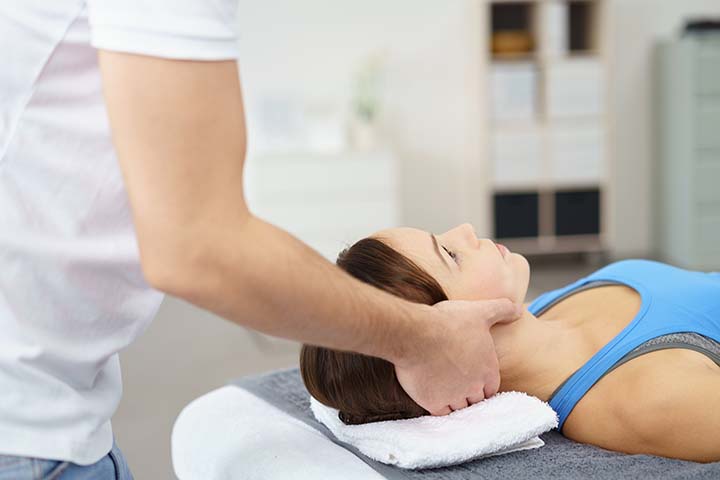22 Jan 2021
How To Get Rid of Neck Pain — And Prevent It From Returning
Estimated read time: 8 minutes
Neck pain is a common condition that negatively impacts the lives of millions of people. An estimated 70 percent of the population will experience neck pain at some point, and in many cases, the discomfort will be intense and make it difficult to lead a normal life. However, it is important to know that there are solutions.
Though it is not considered a serious condition, neck pain affects the quality of life of 25% of the population each year. While it is present in every age group, most studies show a higher incidence of neck pain among women and an increased risk of developing neck pain in those under 49 years old.
What do we mean by neck pain? Are all forms of pain the same? How can we prevent it? In most cases, it is a passing discomfort and only rarely does it become a systemic issue. Still, understanding neck pain is vital to tackling the problem.
What is Neck Pain and What Causes It?
According to the American College of Rheumatology, neck pain is due to overuse of the structures of the cervical spine. The spine supports our entire body, giving it structure, and the cervical section helps keep the head — which can weigh up to 12 lbs. — upright. However, if you tilt your head forward 45 degrees, its weight feels like 45 lbs., significantly increasing the pressure on the muscles and bones of the cervical spine.

When we place our head in an unnatural, awkward, or excessively tense position, these bones and muscles are affected and cause discomfort. The pain can be sharp and last for longer or shorter periods; most cases don’t last more than a week. At most, neck pain can last up to three months.
Sometimes, the pain is focused on the neck area and can be felt when moving the head: looking side to side or raising and lowering the head. In other cases, the pain radiates toward either arm, a condition known as radiculopathy, causing discomfort when a person moves their arms or even partially blocking movement altogether.
In more serious cases, a person can experience dizziness and loss of balance, symptoms that should be reviewed by a doctor as soon as possible.
Common Causes of Neck Pain
Neck pain can have various causes, though the most common ones have to do with posture and are related to our habits and activities.
- Poor posture while sleeping. This is likely the most frequent cause of neck pain. Bad posture, a bad mattress, an inadequate pillow, and other factors can strain the muscles in the neck while you sleep, causing pain that tends to be very uncomfortable.
- Watching TV or looking at a screen. Bad posture in front of a screen of any size is another habitual cause of neck pain. People tend to spend many hours in front of computers or televisions, or simply reading. The muscles and bones stiffen due to a lack of movement and maintaining an awkward position, producing discomfort and pain.
- Brusque or strenuous exercise. Neck pain often appears after intense exercise, if a fast and brusque movement of the neck affects the muscles and causes a lesion. This type of injury is common in people who play sports.
- Falls or accidents. Sudden falls and car accidents in particular can cause a type of injury known as whiplash that produces intense neck pain. It is common in vehicle collisions: in a rear-end car accident, the passengers experience a brusque, sudden movement backward rapidly followed by an intense forward motion. Although a car’s headrests help to limit the rearward movement of the head, whiplashes are frequent and profoundly painful. Often, discomfort appears a few days after the accident, along with stiffness.
- Arthrosis. This condition, increasingly common with age, appears when the cartilage discs that separate the vertebrae become narrower. This leads to bone spurs developing in the spine, causing nerve root compression and pain in the neck and arms.
- Hernias. A herniated disc in the spine can also cause pain in the neck and arms. In these cases, the pain will be more persistent and sharp, and surgery may be necessary.
- Spinal stenosis. This condition is produced by a narrowing of the spinal canal due to bone spurs in the intervertebral discs or other elements that reduce the space within the spine. In many cases, the spinal cord can become compressed and cause pain.

- Crick in the neck (stiff neck). Another common cause of discomfort in the cervical area is known as a “crick in the neck” or a stiff neck. According to experts, this can be hereditary or be caused by an injury to the central nervous system. It can also appear without an apparent cause, and usually leads to difficulty moving the neck in a particular direction, headaches, uneven shoulders, and of course, discomfort in the neck area.
Treatment For Neck Pain
A good diagnosis is key to treating neck pain. It’s important to identify the cause in order to rule out more serious conditions, such as arthritis or stenosis. In many cases, imaging tests such as X-rays, magnetic resonance imaging (MRIs), and CT scans are necessary to detect the source of the problem.
Once the cause of the pain has been located, there are many forms of treatment. The most common include physical therapy or simple at-home exercises to help relax the affected muscles. Painkillers and anti-inflammatory drugs may also be prescribed depending on the type of discomfort. Muscle relaxants and topical pain relief products can help as well.
Applying dry heat to the affected area, such as a heating pad, is another frequent recommendation. People can also practice stretching exercises under a hot shower or relax the muscles using ice packs, in some cases.
How to Prevent Neck Pain

Good news: neck pain is entirely preventable. Neck issues that stem from bad posture are the easiest to address: simply avoiding those body positions can keep the pain away. As an example, experts at Harvard University recommend using a feather pillow, which easily conforms to the shape of the neck. Alternatively, one can opt for a pillow with "memory foam" that remembers the weight and shape of your head for better support. The goal is to keep the head and body aligned to avoid awkward neck positions.
For those who suffer from neck pain produced by spending too much time in front of a screen, the solution may be as simple as getting up periodically to stretch the neck and back. A quick walk may be enough.
Other ways of preventing discomfort:
- A healthy lifestyle. Taking care of yourself and leading a healthy life, with good sleep habits, physical activity, and a nutritious diet.
- An exercise routine. It’s a good idea to regularly perform exercises that help relax the neck muscles. The goal is to practice simple routines that help reduce the stress on the area.
- Quit smoking. Tobacco is a dangerous habit and a risk factor for this condition: it’s been proven to increase the likelihood of suffering neck pain.
- Lose weight. Excess weight is another frequent cause of pain. This leads muscles, bones, and tendons to carry more weight than they can support, causing discomfort.
Walking to Ease Neck Pain
Among the many helpful exercises to ease pain in the cervical area, experts recommend walking. Not just any kind of walk, however, but one that follows a very specific series of movements. When practiced regularly, this simple exercise can help correct decades of bad posture:
- Look straight ahead. If you walk while looking ahead, your head will be erect, helping ensure an upright posture.
- Stretch your spine. When your spine is stretched, the back muscles are working harder, the shoulders are level, and the buttocks are tucked in. The goal is to keep your body as aligned as possible.
- Bend and swing your arms. While walking, your arms should be flexed at 90° angles and swing at waist level. Your fingers should be slightly flexed, but not clenched in a fist.
- Swivel the hips. A slight swivel of the hips can add power to your steps.
- Flex your feet. Flex your feet as you walk, alternatively lifting your heels and your toes. One trick is to imagine a person walking behind you -- they should be able to see the sole of your shoe when you walk.
- Take short steps. It’s better to take short, measured steps rather than long strides to help maintain your balance.
- Distribute your load. If you are carrying any kind of load, the best option is a backpack or any bag with straps that go over both shoulders. Carrying weight on one shoulder only can lead to imbalances and tension.
Learning to walk correctly will help strengthen your neck muscles, significantly decreasing pain in the cervical area. Watching your posture when you sleep and while using screens, and maintaining a generally healthy lifestyle, will take care of the rest.


